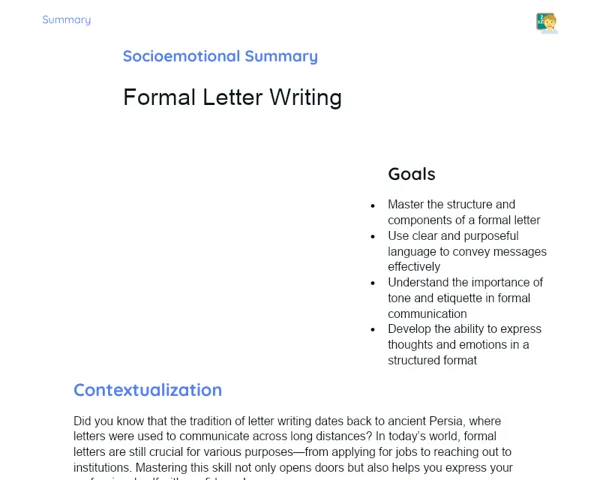Objectives
1. Develop the ability to identify and use the past continuous tense in English, so you can describe actions that occurred at a particular time in the past and may still be relevant today.
2. Examine real-life applications of the past continuous in various situations to boost both fluency and accuracy in your English communication.
3. Enhance your skill to actively participate in discussions by correctly using the past continuous tense.
Contextualization
Have you ever thought about how you can narrate an event from the past that still matters today? The past continuous acts like a thread connecting yesterday's happenings to what's going on now. For instance, saying 'I was reading a book' not only tells of an action in the past but also suggests that the activity was in progress before something else happened. Mastering the past continuous is like having a powerful tool in your kit for enriching your English narrative and understanding more detailed texts.
Important Topics
Formation of the Past Continuous
The past continuous is formed using the past form of 'to be' (was/were) along with the -ing form of the main verb. This structure is used to show that an action was ongoing at a specific moment in the past, often before another action took place. For example, in the sentence 'They were watching TV when the phone rang', 'were watching' clearly depicts an ongoing activity that was interrupted.
-
Use 'was' for singular subjects and 'were' for plural subjects (like you, we, they).
-
The -ing form (gerund) of the verb helps us describe continuous actions, as in 'I was studying.'
-
Using the past continuous gives context to past events, helping the listener or reader understand the order and duration of actions.
Use of the Past Continuous
This tense is excellent for describing an action that was in progress at a specific moment in the past, making it very useful for detailed storytelling and setting the context. It also allows you to express two activities happening simultaneously. For example, 'While I was cooking, she was reading' conveniently shows both actions taking place at the same time.
-
It describes ongoing actions that get interrupted by another action.
-
Helps in narrating parallel actions which occurred at the same time in the past.
-
Commonly used in storytelling, especially when recounting events in a sequential manner.
Differences with the Simple Past
It is important to differentiate the past continuous from the simple past. The past continuous describes actions that were in progress at a specific moment in the past, while the simple past is used for actions that were completed at a definite point in time. For example, 'I was watching TV' (a continuous action) versus 'I watched TV' (a completed action).
-
The past continuous focuses on the duration and continuity of an action, whereas the simple past tells about a completed event.
-
Choosing one over the other can change the meaning of your sentence, which is particularly important in narratives.
-
Understanding these differences helps improve clarity and precision in your use of English.
Key Terms
-
Past Continuous: Formed with 'was/were' plus the -ing form, used to describe ongoing actions at a particular time in the past.
-
Gerund: The -ing form of a verb that indicates an action in progress.
-
Narration: The practice of telling a sequence of events, generally in chronological order, often using the past continuous.
For Reflection
-
How does using the past continuous change the way a story is perceived compared to using the simple past?
-
Why is it important to choose the past continuous over the simple past in certain narratives?
-
In what ways can a good command of the past continuous enhance your understanding of English texts?
Important Conclusions
-
In today's lesson, we explored the past continuous—a tense that connects the past to the present by describing actions that were ongoing at a specific time. This understanding is indispensable not just for fluency but also for crafting richer narratives.
-
We looked at how to form and use the past continuous correctly, and discussed its differences with the simple past. Regular practice of these grammatical structures will surely help you communicate more clearly and engagingly.
-
We emphasized the value of practical scenarios—from everyday conversations to academic texts—in applying the past continuous, showing how widely useful this tense can be.
To Exercise Knowledge
Keep a diary for an imaginary week where you describe all your daily activities using only the past continuous. Include details such as interruptions, simultaneous actions, and the emotions you were feeling at the time. This practice will undoubtedly deepen your understanding of this tense.
Challenge
Time Detective Challenge: Watch an episode of your favourite English TV show and note down all instances of the past continuous. Then, rewrite brief summaries of these scenes correctly using the past continuous in your own words.
Study Tips
-
Use flashcards for practice: write a sentence in the simple past on one side and then rewrite it using the past continuous on the other.
-
Watch English movies or educational videos that use the past continuous within their storytelling. Notice the intonation and context to improve your listening skills.
-
Practice speaking with friends or family who are also keen on improving their English. This mutual learning environment can help you refine your use of the past continuous through gentle corrections and shared experiences.



